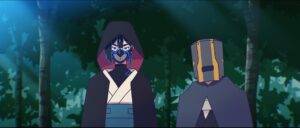If you enjoy what you read below – we hope you’ll join us to read the full Visions article and the rest of the issue by subscribing to Backstory Magazine!
Executive producers James Waugh & Jacqui Lopez and producer Kanako Shirasaki collaborate with Japan’s best anime studios for a new series of shorts set in a galaxy far, far away.
By Danny Munso
Ever since it premiered, Star Wars has gone hand in hand with Japanese culture. George Lucas was incredibly open about how the roots of his blockbuster franchise sprang partially from the films of one of his idols, Japanese legend Akira Kurosawa. Now that inspiration has been repaid, as Lucas’ original and prequel trilogies helped influence the next generation of Japanese storytellers, many of whom are a part of Star Wars: Visions, an anime anthology series of nine short films now streaming on Disney+.
Lucasfilm began plans for a possible Star Wars anime project over five years ago, but nothing came to fruition. Still the company’s staff — led by VP of content & strategy James Waugh and VP of franchise production Jacqui Lopez — were huge fans of anime and never completely took it off the table. “I think the question was how do we do this with Star Wars in the right way,” Waugh says. “How do we do this as authentic as possible?” When Disney+ was announced in 2017, that opened new windows for Star Wars storytelling, and it was then they revisited the anime project. The possibility of a film was explored, but the Lucasfilm folks kept coming back to the same problem: If they collaborated with one specific studio, that would limit the type and style of anime they could use. And then came the idea of working with multiple studios.

“We knew in the beginning we wanted shorts that were different,” Lopez says. “Anime has such a wide breadth of storytelling and styles, so we knew we wanted to go to different creators and studios.” A wide net was cast for not only top studios but those that differed greatly in the style of their releases so the nine pieces would each feel unique and independent. The resulting shorts are bound together by the Star Wars galaxy but could not be more varied, as exemplified by Trigger’s bombastic “The Twins,” the quiet power of Kamikaze Douga’s “The Duel,” Kinema Citrus’ meditative “The Village Bride” or the childlike renderings in Science SARU’s “T0-B1.” In all, seven studios were selected, with Trigger and Science SARU contributing two shorts to the anthology. “If we had a studio that was good with action, we’d go to another that had great heart or whimsy.” Each studio sent up to three pitches, and Lucasfilm curated the series based on the resulting picks. There was no lengthy list of parameters given to the creators, but one major guideline was put in place by Lucasfilm: Keep the most canonical Star Wars characters — the Skywalkers, Han Solo and so on — out of the shorts. “It was part of the framework,” Waugh says. “We weren’t saying absolutely no known characters, but we didn’t want the leads to be characters we know or have all that equity with. We wanted to lean into these talented filmmakers to create their own characters and their own additions to Star Wars.”
The only short that includes notable characters from the Star Wars oeuvre is Studio Colorido’s “Tatooine Rhapsody,” which centers on a Jedi uniting with a member of the Hutt clan to form a rock band. Jabba the Hutt makes a brief appearance, as does his frequent bounty hunter for hire Boba Fett. “For something like ‘Tatooine Rhapsody,’ that idea is so original it almost earned the right to fit those characters into the wider Star Wars universe a little bit,” Waugh says. In fact, “Tatooine Rhapsody” ended up serving as a bit of a template for what Star Wars: Visions would end up being. The short is like nothing we have seen in the Star Wars galaxy. With a big musical number at the end, it’s as far from the feature films and canon TV shows as can be. That’s precisely why it’s one of the standout shorts and feels like a huge breath of galactic fresh air. Once Lucasfilm greenlit that idea, there seemed no end to what types of shorts would work for the project. “That’s one I felt like we rolled the dice on. It was so far out there from what we usually do,” Lopez says. “But it was a really great pitch, and the characters really came out. We thought, Yeah, this is what we can do with Visions, so let’s just see where it goes.”
On normal Star Wars projects, Lucasfilm is the be-all and end-all, with some oversight from Disney. Visions is decidedly different. Lucasfilm brought on some of the best anime studios in Japan, but they also joined up with Qubic Pictures, a New York and Japan-based production management company that specializes in anime. Waugh explains that Lucasfilm was always there both as a sounding board for the filmmakers and to make sure each of the shorts — no matter how out there the concepts may have seemed — felt like Star Wars. “It was certainly their story and their vision,” he says, “but we were all great partners in the process. We were there along the way to make sure they were getting good editorial and also getting good perspective on Star Wars values. We wanted to make sure these were authentic Star Wars stories with that mythic and emotional quality we’ve come to expect.”

An example of this collaboration can be found in one of the best shorts in the series, Production I.G’s “The Ninth Jedi,” which is set in a time when the Jedi are mostly extinct. New character Margrave Juro reaches out to the corners of the galaxy to find seven new Jedi and have them meet him at his temple. He instructs a sabersmith named Zhima to construct new lightsabers for the seven, but Zhima is attacked by the Sith before he can deliver them. Instead, he gives them to his Force-sensitive daughter Kara to give to the Jedi, but when she arrives, she and Juro discover most of the Jedi who answered the call are actually Sith. It’s an epic tale that truthfully could have been even longer than its 23-minute runtime. When director Kenji Kamiyama pitched his story to Lucasfilm, it was actually two separate ideas: one about a sabersmith and one about a search-gone-wrong for new Jedi. It was Lucasfilm’s idea to marry the two. “We started talking with [Production I.G] and realized these stories were set in the same world,” Lopez says. “So they started connecting the two, and it evolved into one big story beautifully and naturally.”
Preproduction on Visions began in January 2020, two months before the COVID-19 pandemic would shut down the world. The pandemic, of course, had a major impact on production of the series, although none of that strife shows up in the finished product. “We were set to go to Japan in April and kick off the start of it at every studio, and then we know what happened,” Lopez says. “It was a bummer not to have that face-to-face, especially right at the beginning when we were all just getting to know each other. So it was all done via Zoom with translators.” Qubic’s Kanako Shirasaki, who served as a producer all nine episodes, was a key go-between with the many studios. “There was a huge mutual respect between all the parties,” she says. “It ended up being a very fun collaborative process.” Waugh admits it was frustrating to not be able to forge those crucial relationships in person. “Being in proximity can make a difference,” he says of triumphing over the lost opportunity. “These were all new relationships and there were seven of them, and we really wanted to get a chance to know the creators. But look, the whole world was going through this process. The studios realized we were there to help them realize their vision, as opposed to giving notes for the sake of notes and trying to change what their intention was. Everyone rose to the challenge, and the work speaks for itself.”
Visions ended up being something of a revelation. Freed from the confines of the wider canon, the nine shorts feel fresh but still very much in line with Lucas’ original vision. “Star Wars has a special place in Japanese people’s hearts,” Shirasaki says. “You can feel that love in each one of these.” Of course, this begs the question of whether there will be a season two. When prompted, the producers go unnaturally quiet until Lopez grins and says, “That would be a great idea.” It’s safe to say that when it comes to collaborations between Star Wars and Japan, Visions is likely only the beginning.
Read the rest of our VISIONS coverage:
The Duel interview
Tatooine Rhapsody interview
The Village Bride interview
The Elder interview
Star Wars Visions is streaming on Disney+ now
Subscribing to Backstory gives you access to our entire catalog of back issues with tons of past Star Wars coverage including in-depth interviews with Dave Filoni and Rian Johnson, coverage of animated series like Rebels and Resistance, interviews with Marvel comic writers Jason Aaron and Kieron Gillen, and features with The High Republic architects Cavan Scott and Daniel Jose Older.
You can use coupon code: SAVE5 to take $5 off your subscription and get instant access! All you need to do is click HERE to subscribe!
There’s plenty more to explore in Backstory Magazine issue 45 you can see our table of contents.
Thanks for your support and stay safe and healthy!